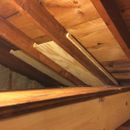Replacing roofing shingles, should we add plywood on top of the original pine decking?
Hey GBA,
We’re planning to replace our roofing shingles on a 1 story ranch built in 1950s located in Massachusetts. Inside the attic we see the roof decking is 3/4″ or 7/8″ x 12″ pine boards. The boards appear in good condition but I was curious if we should add a layer of 1/4″ or 3/8″ plywood (not OSB) on top of the pine decking prior to installing new shingles. I thought the reason for doing so would add these benefits.
1. Seal the number of gaps between the pine boards. Ranging from 1/16″ to 1/4″.
2. Provide a more stable sub surface for the shingle material. (Sometimes the nails are shot in between the gaps by accident)
3. Adding a thin layer of plywood would offer better moisture resistance/durability compared to adding a layer of OSB.
Attached is a photograph of the new baffles next to the pine decking.
GBA Detail Library
A collection of one thousand construction details organized by climate and house part










Replies
Most roofing brands are fine with a 1/4-inch gap between board roof sheathing (with the caveat that you have to watch your fastener placement). For some examples of relevant technical bulletins search: GAF TAB-R-2011-139 or Owens Corning TB-10022499-BW. CertainTEED has a Technical Information Sheet 168 that covers the same thing, but I can't find it online.
That said, I had a bad experience with an inspector who told a client that the installation of asphalt roofing over board sheathing was not something the inspector would have approved if the inspector knew about it in advance. It caused serious relationship issues with the client, who thought we had 'cheaped out' even though we showed them the technical bulletins from the manufacturer allowing install over board sheathing, and the inspector signed off on it just fine.
I think it was just a one-off bad experience, but figured it was worth mentioning.
Hi Sam,
Thanks for sharing that insight. I will look at the local code and check to be certain.
I think MA is on 2015 IRC/IEBC.
You probably aren't going to find anything enlightening in the code. The sheathing requirement for installing asphalt roofing in the 2015 IRC is very simple: "Asphalt shingles shall be fastened to solidly sheathed decks" (R905.2.1). I mean, you can dig out the structural roof sheathing requirement to figure out what sheathing is allowed, but it isn't going to help you decide whether a 1/4 gap is OK.
What ends up happening is that you will read the whole asphalt section and then realize that section R905.1 is what really applies to your question and that section states "Roof coverings shall be applied in accordance with...the manufacturer's installation instructions." And that kicks you back to the shingle manufacturer's technical bulletins on the subject.
Let me know if you find information to the contrary, I'm always open to being incorrect.
I'm no roofer, but...
They've been there 70 years now, they "appear in good condition", and they haven't caused any obvious problems so far... I'd say that's a win.
If they were shorter (eg 2x4 boards) I'd say that the shear strength of plywood/osb is a lot higher, but the shear strength of 12 inch boards for connecting 16 inch on center rafters is going to be much more comparable to sheet goods.
Are the boards just rectangular in profile, or are they shiplapped / T&G'd / mitered to shed water?
The boards are rectangular, no ship-lap or tongue and groove.
Board sheathing is very common in my area and they are always shingled as is. About the only time you touch it is to fix damage from roof leaks. I'm not in a high wind or seismic area, those need different considerations.
I would say yes. Sometimes those old boards can be all dried up and brittle and will split or break when nailed or walked on. Adding new plywood would get rid of all those gaps, plus it will help with snow loads or any other future load the roof may see.